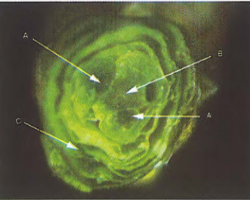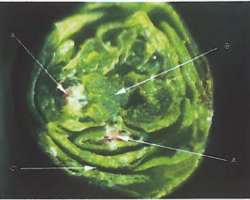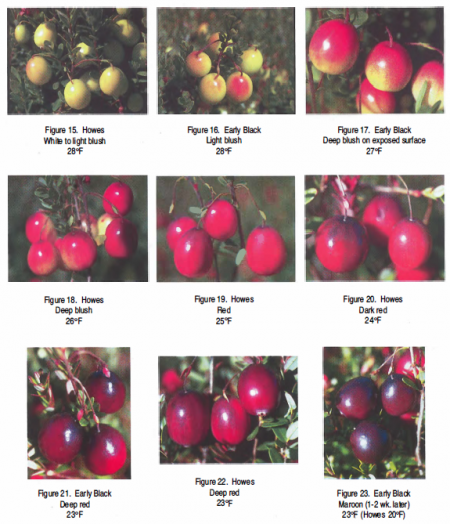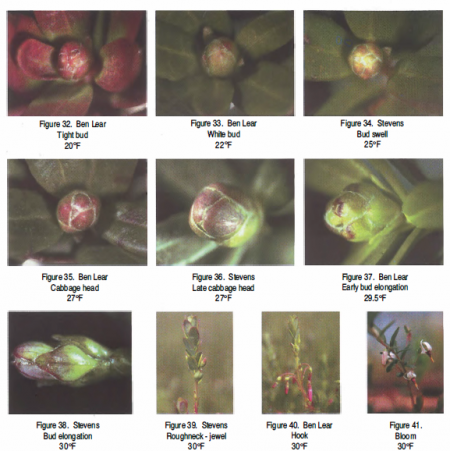Frost Protection Guide (1998)
FROST PROTECTION GUIDE
FOR MASSACHUSETTS CRANBERRY PRODUCTION
Carolyn J. DeMoranville
Cranberry Experiment Station, University of Massachusetts
Spring frost tolerances for Early Black or Howes
Tolerance for both cultivars is the same at each stage
Cold hardiness of cranberryflower buds. During the winter, cranberry buds are cold hardy to temperatures below 0°F. As the plants break dormancy in the spring, the buds become more sensitive to freezing temperatures. Terminal buds containing the floral initials, that will become the flowers, are round and tight (Figures 1, 2, and 32). Frost tolerance is estimated based on bud appearance (front and back pages).
While terminal buds can survive exposure to 12°F and lower soon after the removal of the winter flood, by the time the foliage is re-greening in mid-April, the tolerance has risen to 18°F with the buds remaining tight and red (winter dormant color). As buds swell, sensitivity increases dependent on cultivar. Those with large buds (and large fruit) tend to become sensitive earlier in their development compared to small-budded cultivars. For example, Ben Lear and Stevens tolerate temperatures no lower than 29.5-30°F once the terminal bud begins to elongate (Fig. 37), while at that same stage, Early Black and Howes will tolerate 27°F (Fig. 7). Ben Lear was the least frost tolerant cultivar in early April, rapidly losing its ability to tolerate 18°F, often prior to complete loss of dormant color in the buds. Early Black had the greatest hardiness in early spring, often tolerating temperatures as low as 15°F (Fig. 1 ). Flower bud populations on a cranberry bog may be quite variable in early spring, with tolerance stages from 15-20°F represented. By late April, both Stevens and Ben Lear become more frost sensitive than Early Black and Howes of similar developmental stage. From the roughneck stage (>1/2 inch new growth) onward, temperatures below 30°F will cause damage to young cranberry leaves and flowers. Newly formed green berries are also sensitive.
| Appearance of the bud | Frost Tolerance EB and Howes | Frost Tolerance Ben Lear and Stevens |
| Spring dormant (bud reddish) |
18°F | 20°F |
| White bud stage (loss of dormant color in bud) |
20°F | 22°F |
| Slight loosening of bud scales (no bud swell) |
22°F | 25°F |
| Bud swell (cabbage head or popcorn stage) 2mm bud |
25°F* | 27°F |
| Bud elongation bud is growing out (or up) |
27°F** | 29.5°-30°F |
| Roughneck (more than 1/2 inch new growth) through hook stage | 29.5°-30°F | 29.5°-30°F |
* After 5-7 days - increase to 27°F even if no change in appearance.
** After 5-7 days - increase to 29.5°-30°F even if no change in appearance.
Frost tolerance after late water. During late water, the appearance of the terminal bud is arrested at the spring dormant stage. However, internal changes occur within the bud so that when the flood is removed, the buds must be protected at higher temperatures than would be expected based on appearance alone. Research has shown that a one week flood early in the spring had no impact on tolerance. However, even two weeks of flooding led to loss of tolerance so that the tolerance could not be predicted by the appearance of the plants. If you use short duration late water floods (2-3 weeks), you must protect for 27°F (after 2 weeks) or 30°F (after 3 weeks or the standard 4 weeks).
Weather facts and tips
Dewpoint. When evening dewpoints are high, the danger of frost is less. If dewpoints around the state are variable, bog temperatures around the region will also vary. Low evening dewpoint can be an indication of a dangerous frost.
Wind. Cold wind during the day lowers temperatures and often dies during the night, increasing the danger of frost. The presence of wind can prevent radiational cooling and protect from frost but should not be relied upon. If the wind drops, bog temperatures may drop as much 1 O degrees in two hours. Winds of less than 10 mph associated with high pressure seldom hold through the night.
Air masses. Cold air moving into the region from Hudson Bay generally lasts one night, while a mass moving from the west with the high centered over the Great Lakes may bring several cold nights. The most dangerous location for a high pressure cell is directly over the cranberry area or slightly to the south and west. As the high approaches and winds die, quite cold temperatures ( often below those predicted) may develop.
Clouds. High clouds are of little value in preventing frost conditions. On the other hand, low clouds persisting until after midnight can be protective - temperatures often drop only one degree per hour after they dissipate.
Precipitation. Substantial rain (1-1.5 inches) within a day or so of cold conditions may prevent temperatures from reaching the critical level. However, this is not a sure thing. Drought conditions increase the danger of frost.
Timing. Critical temperature is often not reached until near dawn in the spring. In the fall, the critical temperature may be reached quite early in the evening. Late in the fall, the temperature may fall below the tolerance just after dark.
Internal appearance of terminal buds. Examination of cut buds can be useful for two purposes: 1) confirming breaking of dormancy and 2) checking for frost damage. Fig. 11-13 show cross sectional views of the interior of terminal buds containing floral initials ('A'). To cut a bud cross section, remove the leaves around the bud, lay the upright on a flat surface, and cut through the bud half-way between the top of the bud and the point where the bud joins the stem. Use a sharp, thin blade - a razor blade works well. As the plant breaks dormancy in the spring, the interior of the bud loses the winter red color and becomes bright green (Figure 11 ). As development progresses, the floral initials begin to look like flower buds, taking on a pink color (Figure 13 'A'). The central tissue in the bud is the vegetative meristem ('B'), that will become the leafy area above the flowers and fruit. Vegetative buds (those with no floral initials) have only the vegetative meristem ('B') and the external bud scales ('C'). The overall appearance of such buds is looser and more pointed compared to the flower-containing terminal buds.
Frost Protection Checklist-Spring
- Make sure the irrigation system is in place prior to the frost season. Maintain the sprinkler system in good condition. Make every effort to assure that water distribution is uniform. Remember that 0.1 inches/hour is the target application rate for frost protection.
- Sign up for the Cape Cod Cranberry Growers' Association frost warning service.
- Calibrate and check thermometers and sensors. Locate sensors at vine level in the coldest area of the bog. Use more than one thermometer per bog if feasible. Do not rely on off-bog thermometers.
- Scout bogs to determine tolerance using the illustrations in this booklet. Plan to protect for the most sensitive stage present in more than 1 % of the buds.
- Monitor the weather forecast. Use the weather tips on page 3.
- On cold nights, run sprinklers at idle when temperature is below 25°F to avoid freezing in the lines.
- If the forecast calls for temperatures well below 20°F and below the tolerance, consider using a frost flood (see page 6).
- Start sprinklers 2-3°F above tolerance and continue running until temperature has risen above tolerance the next morning.
- Do not rely on wind and clouds - monitor temperatures and protect as needed.
- Remember that the coldest spring temperatures often occur near dawn.
- Flowers and green fruit are sensitive to temperatures below 30°F. Keep this in mind during cold periods in the summer.
How to diagnose frost injury.
Frost injury is not always visible to the naked eye but the symptoms can be noted upon careful examination. A flower bud that is injured in the early spring will exhibit a brown center when cut in cross section (Figure 14). This injury is visible in 24 hours. Subsequently, the bud center will turn black. Buds injured later in the spring may sustain injury only to the vegetative portion of the bud ('B' in Figures 11-13). Such buds may go on to produce flowers with no vegetation above them - the so-called 'umbrella bloom'. Occasionally, only one or two of the floral buds ('A' in Figures 11-13) will be injured and will appear brown when the bud is cut in cross section. In such cases, the upright may produce some flowers and leaves. Berries that have sustained frost damage in the fall become opaque and soft. Such berries do not burst readily when squeezed, however.
Fall frost tolerances for Early Black or Howes
Tolerance for both cultivars is the same until late season (Figure 23)
Fall frost tolerances for Ben Lear or Stevens
Tolerance for both cultivars is the same at each stage until deep red (see Figures 28-31)
Cold hardiness of cranberry fruit. Late in the summer the fruit turn white then develop a faint blush on exposed surfaces. At that point the tolerance of the fruit is 28°F (Figures 15, 16, and 24). For all culitvars studied, maximum cold hardiness in the fruit was associated with full mature color. However, the maximum tolerance temperature at full maturity was different for each cultivar ('maroon' in the table). At full maturity, 95% survival after short (1-2 hour) exposures to temperatures as low as 18°F has been observed in Early Black, Howes, and Stevens. In some years, • over-ripe fruit (2 weeks after maximum color) showed loss of tolerance, with all cultivars damaged by 22°F or lower.
This fall tolerance table is based on color development, which is used as a visual guide to ripening, a cliemical and physiological process. In some years, lower tolerances were found. However, we cannot predict when this will occur so conservative figures are presented. In each of three years, cranberries showed tolerances at least as low as these for the stages listed.
Protecting cranberry bogs from frost injury. Preventing frost injury to the flower buds in the spring and to the fruit in the fall is arguably the single most important cultural practice in cranberry production. Frost injury is the only hazard in cranberry production where major crop loss can occur in as little as one hour and total crop loss in one night. Virtually all frost protection is achieved through the use of low-gallonage sprinkler systems. However, flooding for frost protection remains an option on very cold nights in early spring and when mechanical failures occur in the sprinkler system.
Sprinkler irrigation: Protection from frost damage by the use of water sprayed on the plants works because of a basic law of physics. As water freezes, heat is given off. This phenomenon is known as the 'heat of fusion'. Water freezes at 32°F, two degrees above the most sensitive stage of the cranberry plants. As long as water continues to freeze and give off heat, the plants are protected. If the supply of liquid water runs out due to the cessation of sprinkling, however, the temperature of the ice-encased plants will quickly equalize with the temperature of the air surrounding them and injury will occur. Sprinklers applying a minimum of 0.1 inch per hour are required to afford adequate frost protection. The system should be turned on at from 2-3°F above the tolerance. This will ensure that the bog is protected even if the monitoring thermometer is not located in the coldest spot on the bog. However, all efforts should be made to locate monitoring thermometers at the coldest parts of the bog. The thermometers or sensors should be placed at the level of the vine tips, the tissue to be protected. It may be necessary to run the system at idle when temperatures are below 25°F so that the water in the irrigation lines will not be frozen when the time comes to begin protecting. Once started, the sprinklers are run until at least sunrise or until the bog temperature is above the tolerance. As the ice on the plants melts, heat is absorbed. If the air is still cold, this heat will come from the plants and damage may occur.
Flooding: While sprinkler irrigation is the method of choice for frost protection, flooding may also be used. In the early spring, flooding is a superior method if temperatures are very low and below the bud tolerance and there is wind. Under such circumstances, sprinkler heads will freeze up, offering little protection to the buds. Sprinkler heads often freeze at temperatures of 14°F or lower, regardless of air m>Vement. A flood may also be necessary if there is a failure in the sprinkler pumping plant. Probably the most important consideration in flood frost protection is the fact that water must be present on the soil surface under the cranberry vines before the occurrence of critically low temperatures. This requires sure knowledge of the length of time required to put the protecting flood in place in advance of the coming frost. It is practically useless to apply the frost flood after the arrival of critically low temperatures. Early in the spring frost season, and until the frost tolerance of the cranberry buds is as high as 25°F the frost flood may be "held over" as a safeguard against the frost hazard of the next night or two. The advantages of this management in saving water and labor are obvious. Using floods at later stages is uncommon, but if you do flood, remove the water promptly after dawn to avoid damage to tender new growth. Flooding for frost protection in the fall is most unusual. However, a flood may be applied to a bog a day or so ahead of harvest to protect it from frost once the sprinkler heads have been removed in preparation for harvest.
| Maurity level* | Early Black | Howes | Stevens | Ben Lear |
| Deep blush, exposed surface | 27°F | 27°F | 27°F | 27°F |
| Deep blush | 26°F | 26°F | 26°F | 26°F |
| Red | 25°F | 25°F | 25°F | 25°F |
| Deep red | 23°F | 23°F | 23°F | 24°F |
| Maroon (1-2 weeks later) | 23°F | 20°F | 22°F | 24°F |
| Over-ripe (end of October) | 23°F | 23°F** | 23°F** | 24°F |
*Note that each variety will reach a given stage on a different date. Generally, Early Black and Ben Lear will both color early and Howes and Stevens will color later.
** loss of tolerance when over-ripe
Frost management facts and tips
What is a frost night? In practical terms, a frost night is any night when the temperature on the bog falls below the tolerance temperature of the buds (spring) or the berries (fall). However, certain conditions are associated with increased frost danger due to an increased liklihood that the on-bog temperature will be lower than that in the surrounding uplands. Cranberry bogs tend to be the lowest feature in the landscape. This leads to cold air draining into the bogs. In addition, the large amount of vegetation on the bog is very efficient in radiating heat into the atmosphere. This 'radiational cooling' is most apparent when skies are. dear and winds are calm - the 'perfect frost night' . Under these conditions, the onbog temperature can be 10 degrees colder than the surrounding non-bog areas, and sometimes as much as 20 degrees colder.
Frost warning service. The Cape Cod Cranberry Growers' Association provides this service to its members . The warning consists of a predicted on-bog mini mum temperature at East Wareham, weather information for that night and the next, and an update on the frost tolerance of buds or fruit on the State Bog. The predicted minimum bog temperature is calculated using formulas developed by Henry Franklin in the 1920s and has proven quite accu rate in predicting the minimum temperatu re that can be expected under 'ideal' frost conditions - clear skies and no wind. If these conditions are not present, on-bog tem perature should not reach the predicted minimum.
When to protect. In order to decide when to protect from frost injury, you must 1) determine the tolerance of the buds or berries, and 2) determine the temperatu re on the bog. Cranberries should be protected from freezing temperatures whenever the on-bog temperature approaches the frost tolerance temperature of the plants. The tolerance changes during plant development as shown in the photographs on pages 1, 4, 5, and 8 of this booklet. At all stages, cranberries will tolerate temperatures of 30°F or higher so it could be argued th at if one protects for that temperature at all times, no injury will occur. While this is true, such a practice is unwise. Water is wasted. In the spring the soil can become waterlogged, interfereing with the ability of the plants to take up nutrients. In the fall, water supplies should be conserved for harvesting. In order to protect for the tolerance, accurate information must be gathered regarding the temperature on the bog.
Locations of thermometers or sensors. Temperatures vary from bog to bog and within a bog. In general, certain bogs will tend to be colder than others and certain locations in the beds will be consistently coldest. A thermometer or sensor should be located in each bog, at the coldest area of that bog . This location will be determined by placing several thermometers at different locations for comparison. The thermometer or sensor should be reading at the level of the vine tips - the location of the terminal buds in the spring. This placement may also be used in the fall. It is an excellent practice to have thermometers or sensors at two or more locations on a bog. This is insurance against equipment failure and against that one night when the cold spot moves to a new location in the bed! The normally coldest bog should be checked first. However, check all bogs even if thie first one has not reached the critical temperature. Occasionally, a different bog is the 'coldest' on a given nig ht. Do not rely on temperatures taken from other bogs, or off-bog locations. 'My bog is always 10 deg rees colder than my house' on ly works until the night when it is 15 deg rees colder!
How to protect. Sprin kler irrigation is the industry standard for frost protection but floods may be used on occasion. See 'Protecting bogs from frost injury' on page 6. Sprinklers should be started before the tolerance is reached in case of technical problems and to insure that adequate protection is in place when the tolerance temperature is reached. It is important to continue running until the temperature is above the tolerance, often well after dawn, especially in the fall. Remember that the coldest temperatures in the spring often occur in the hours before dawn, while the temperature may be below the tolerance shortly after dark in the late fall.
Frost Protection Checklist - Fall
- Tolerance of green berries is 30°F. Once they tum white and begin to show a blush on exposed surfaces, tolerance begins to drop (see pages 4 and 5). Scout for tolerance.
- Calibrate and check thermometers and sensors. Locate sensors at vine level in the coldest area of the bog. Use more than one thermometer per bog if feasible. Do not rely on off-bog thermometers.
- Monitor the weather forecast. Use the weather tips on page 3.
- On cold nights, run sprinklers at idle when temperature is below 25°F to avoid freezing in the lines.
- Shallow floods can be applied to protect bogs where sprinkler heads have been removed for harvest.
- Start sprinklers 2-3°F above the tolerance and continue running until the temperature has risen above the tolerance the next morning. This may take untill well after dawn in the late fall.
- Do not rely on wind and clouds - monitor temperatures and protect as needed.
- Remember that the coldest fall temperatures often occur early - as early as dusk in the late fall. You may need to act prior to the evening frost warning in such cases.
Spring frost tolerances for Ben Lear or Stevens
Tolerance for both cultivars is the same at each stage
Published by the Cranberry Experiment Station, University of Massachusetts Extension, College of Food and Agriculture. United States Department of Agriculture cooperating. UMass Extension provides equal opportunity in programs and employment. Publication supported in part by a grant to C. J. DeMoranville and H. A. Sandler from Massachusetts Department of Food and Agriculture Agro-Environmental Technology Grants Program, with additional support from the Cape Cod Cranberry Growers Association.
Carolyn DeMoranville is Extension Assistant Professor at the Cranberry Experiment Station.
Photography and artwork by Meredith Albright, freelance scientific illustrator, Bellingham, MA.







